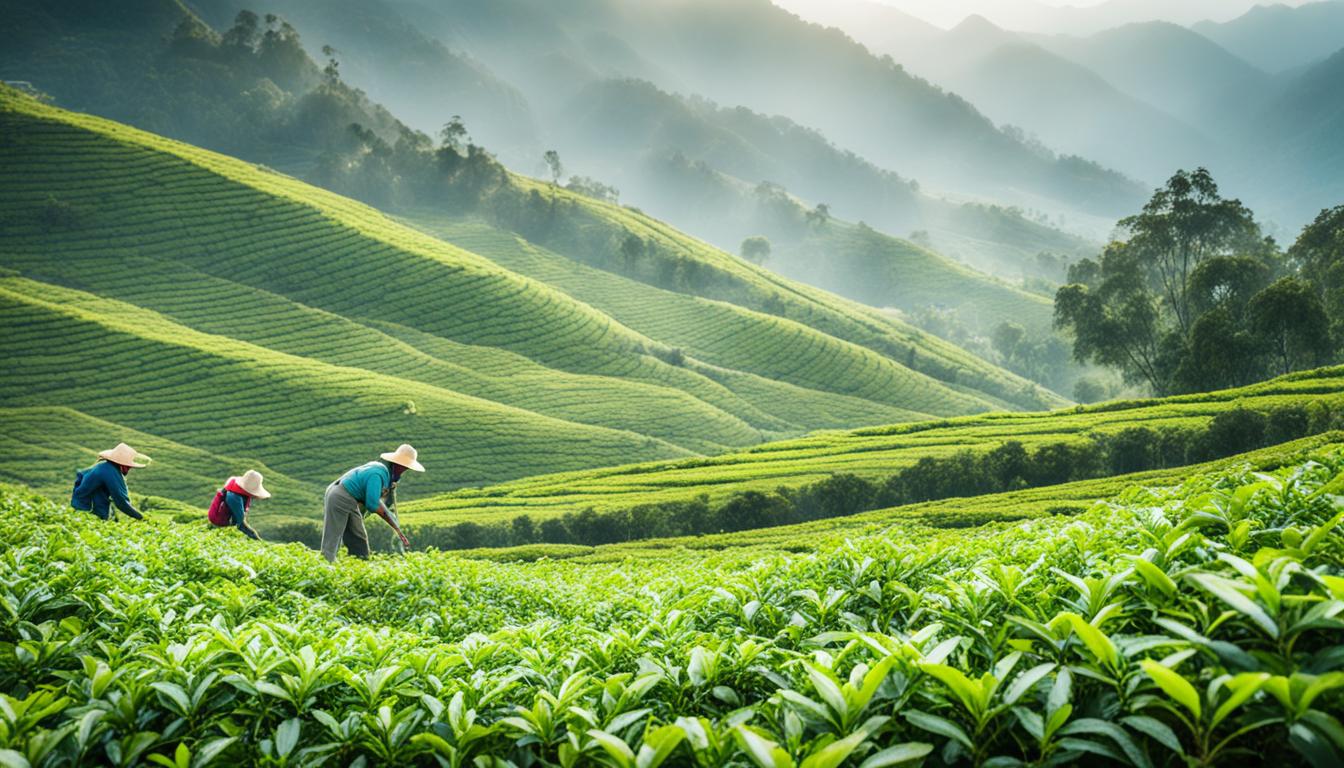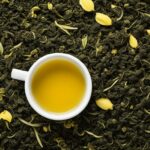The world of tea is steeped in a history as rich and varied as its flavors, but among its many varieties, the origin of white tea leaves stands out as a story of elegance and tranquility. From the mist-enshrouded hills of traditional white tea growing regions to the carefully nurtured gardens where each leaf is treated with reverence, the journey of white tea is a testament to the artistry and devotion that has shaped its legacy.
Tracing the lineage of white tea is an expedition through time and culture, where ancient practices meet the sophisticated craft of today’s artisanal producers. The serene origins of white tea, rooted deeply in the heritage-rich soils of lands far and wide, are enveloped with gentle whispers of history and the subtle complexities that capture the senses.
Join us as we unfold the delicate layers that comprise the prestigious narrative of white tea, a beverage that continues to enchant and revitalize spirits with its understated grandeur and its intimate connection to the Earth’s purest expressions of nature.
Key Takeaways
- Discover the serene and sophisticated history of white tea origins.
- Explore how traditional white tea growing regions influence the unique character and quality of white tea leaves.
- Uncover the ancient practices that have meticulously shaped the cultivation of white tea through centuries.
- Understand the influence of terroir in crafting the subtle complexities found in every cup of white tea.
- Experience the tranquility and cultural richness enfolded within the white tea traditions.
Exploring the Roots: The History of White Tea
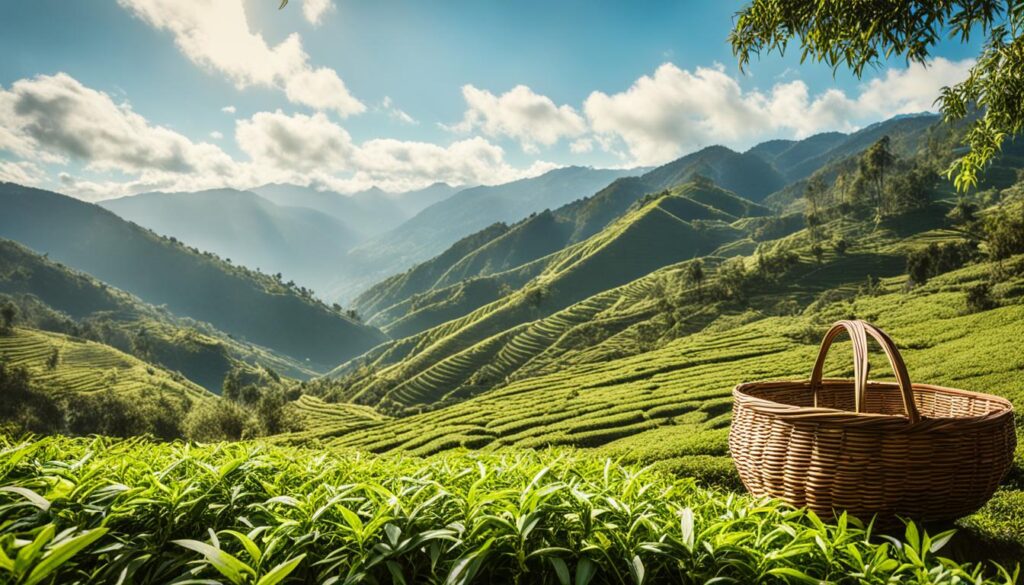
The history of white tea unfolds like a carefully steeped brew, one that traces its lineage back to the rugged and lofty landscapes of ancient China. A treasure among tea connoisseurs, the origins of this delicate tea are shrouded in tales of imperial favor and monastic ritual. Praised for its gentle flavor and medicinal properties, white tea has evolved from a luxury of the few to a pleasure enjoyed by many around the world.
White tea varieties, each with their own distinct presence, are the offspring of both heritage and botanical evolution. Narratives from early Chinese dynasties highlight emperors who found solace in the subtleties of white tea flavors, and monks who considered its consumption a doorway to spiritual clarity. It is not merely a commodity, but a living history that continues to captivate with its whisper of erstwhile sophistication.
- Bai Hao Yin Zhen: Also known as Silver Needle, this is the most prized variety, crafted exclusively from the first flush of young buds.
- Bai Mu Dan: Or White Peony, comprises both buds and leaves, offering a fuller flavor with a hint of earthiness.
- Shou Mei: A more robust tea with a diverse collection of leaves, conveying a stronger and fruitier flavor profile.
Emperor Huizong of the Song Dynasty once described white tea as the epitome of elegance, with each sip reflecting the harmony of nature.
This reverence for white tea has not waned over the centuries; instead, it has flourished, with modern production techniques intertwining with time-honored traditions. These practices have safeguarded the tea’s legacy, allowing the sophisticated flavors to journey from the past into the cups of present-day enthusiasts. To this day, the history of white tea remains a testament to human dedication to craft and culture.
| Variety | Description | Flavor Notes |
|---|---|---|
| Bai Hao Yin Zhen | Pinnacle of white teas, made from the first buds of spring. | Delicate, sweet, with a light honeyed scent. |
| Bai Mu Dan | Buds and young leaves, slightly more robust than Silver Needle. | Floral, mellow, with a touch of pecan. |
| Shou Mei | Crafted from mature leaves, it is considered a darker white tea. | Bold, fruity, and reminiscent of autumnal notes. |
From the Fields to Your Cup: White Tea Production
Embark on a transformative journey through the meticulous world of white tea production, where every step from leaf to cup is an exemplary showcase of precision and tradition. This section casts a spotlight on the dedicated practices that contribute to white tea’s unique and celebrated taste profile.
The Delicate Process of Harvesting
In the break of dawn, skilled farmers in origin countries like China, India, and Sri Lanka engage in the annual ritual of white tea harvesting. This begins with the delicate plucking of the youngest tea shoots and leaves, a task requiring hands as steady as a surgeon’s. The favorable climatic conditions of these regions, along with their rich soil, set the stage for producing tea leaves that are as pure as the morning dew.
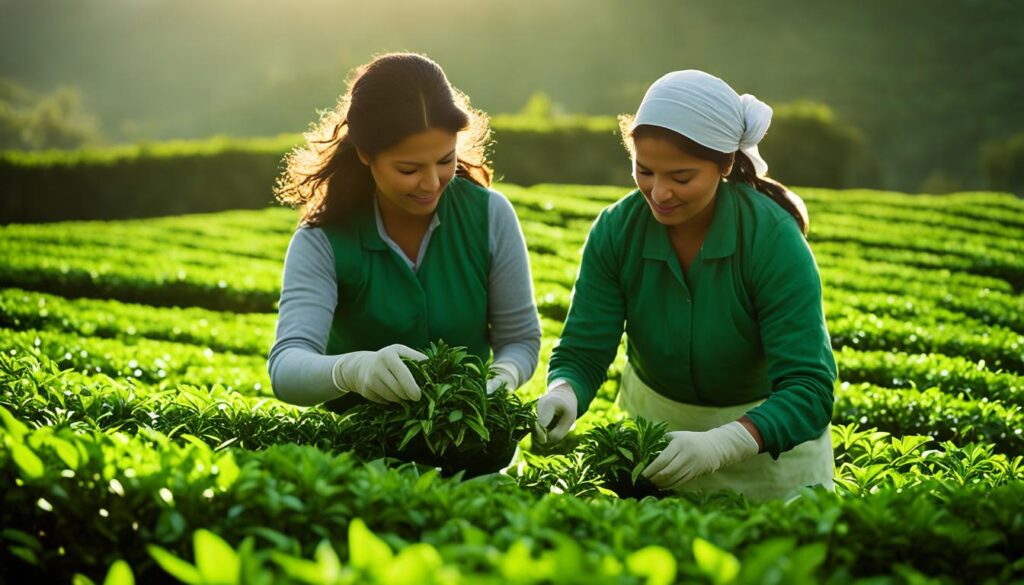
The timing of the harvest is integral, literally capturing the essence of the tea at the optimal moment. Once plucked, the leaves are treated with utmost care to prevent bruising, as preserving the inherent properties of the leaves is paramount for the highest quality product.
Fermentation and Drying: Perfecting the Taste
White tea undergoes minimal processing, which includes a carefully controlled natural fermentation — a transformation that amplifies its subtle flavors while maintaining its pale color. The drying of the tea is a watched-over process, traditionally carried out in the sun or in specialized environments ensuring the signature soft, sweet taste of white tea production remains intact. The mastery behind these processes are deeply rooted in the trade secrets of the white tea origin countries, passed down through generations.
Inspection and Sorting: Ensuring the Highest Quality
The final act in the production of white tea is a thorough inspection and a rigorous sorting procedure. Each leaf is examined to ensure it meets the exalted standards that aficionados around the world have come to expect. Only the best leaves survive this final vetting process, ensuring a pristine product that is ready for packaging and distribution. This level of care and attention solidifies the reputation of excellence behind every cup of white tea.
Geographical Wonders: Regions Famous for White Tea
White tea, the epitome of refinement in the tea world, is influenced greatly by the geography of the regions where it is grown. The traditional white tea growing regions, imbued with a rich history and a favorable climate, share the spotlight in cultivating this subtle and prized tea. Here, we pay homage to the territories that have made white tea notorious on a global scale.
- Fujian, China: The birthplace of white tea, Fujian province’s misty mountains offer a perfect environment for growing the delicate tea buds that are handpicked with scrupulous care.
- Yunnan, China: Yunnan’s diverse biodiversity and altitude contribute to the distinctive flavors found in the white teas here, standing out as a prestigious white tea origin country.
- Darjeeling, India: With its own unique teas known as the “Champagne of Teas,” Darjeeling has introduced its variety of white teas, which bring a mix of crispness and muscatel grace to the palate.
- Nuwara Eliya, Sri Lanka: Nuwara Eliya, known for its Ceylon teas, has ventured into white tea production, leveraging its cool climate and rich soils to produce teas with a delicate yet profound character.
The harmony between the land, the climate, and the artisanal knowledge weaves a narrative of quality and exclusivity inherent to white tea from these renowned producing regions.
| Region | Country | Notable Characteristics |
|---|---|---|
| Fujian | China | Original white tea cultivars, ancient methods, and a rich cultural heritage. |
| Yunnan | China | Diverse terrain, complex flavor profiles with a rich mouthfeel. |
| Darjeeling | India | Elevational influences creating a diverse range of flavor notes. |
| Nuwara Eliya | Sri Lanka | High altitude gardens, a cooler climate contributing to a refined taste. |
Each region, with its unique terroir and environmental factors, contributes to the tapestry of flavors and qualities that white tea aficionados have come to cherish.
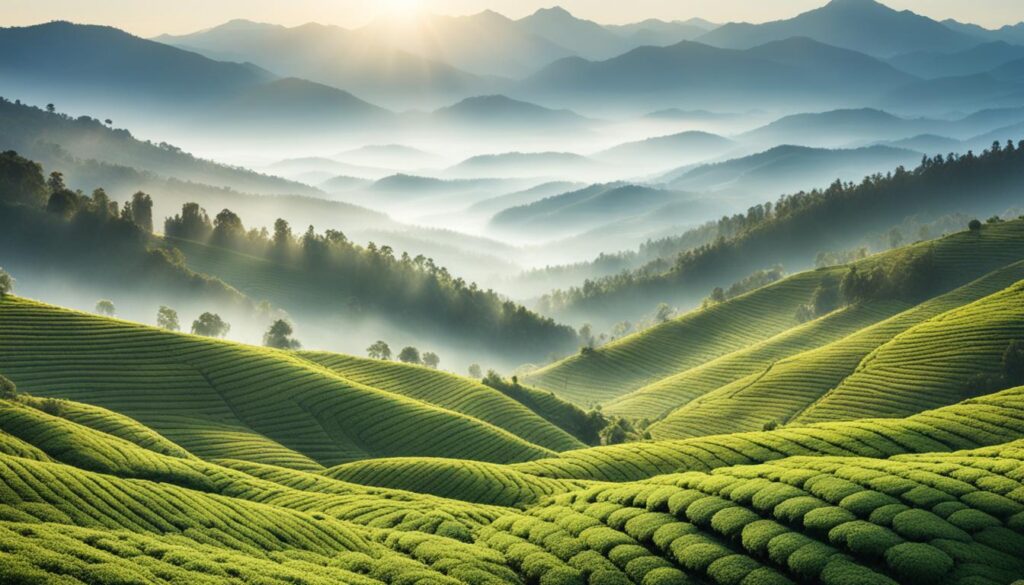
Conclusion
As the curtain falls on our explorative narrative, we reflect upon the white tea origins, immersing ourselves in the legacy that steeps in every porcelain cup. A beverage both delicate and powerful, white tea embodies the serenity of ancient traditions, offering a sip of history with each nuanced flavor. The history of white tea whispers tales of meticulous cultivation—a reminder of the timeless art that has flourished in the heart of traditional white tea growing regions. With reverence, we acknowledge the collective history and culture encapsulated within this prized elixir.
The artisans of white tea production perpetuate its narrative, guardians of the age-old methodologies while embracing subtle innovations. Their devotion ensures that the elegance of white tea continues to resonate across continents, bridging past and present in its understated complexity. It is not merely a commodity but a cultural touchstone that honors the earth from which it springs and the hands that bring it to life.
In drawing our journey to a close, we encourage a newfound honor for the tranquil pace and rich tapestry that is white tea. Let the calm of its origins and the poetry of its existence inspire you to delve deeper into the heritage, to savor the delicate dance of flavors that promise both tranquility and a rediscovery of a time-honored practice. It is our hope that your next encounter with white tea extends beyond mere consumption, and into an appreciation of the history, craftsmanship, and serene intensity that is its true essence.
FAQ
What are the origins of white tea?
White tea has its roots in ancient China, with a history that dates back to several centuries. It is believed to originate from the Fujian province, where the traditional cultivation and processing methods were developed to create this delicate and revered tea. Its origin is deeply connected with the serene landscapes and skilled artisans of these traditional white tea growing regions.
How has the history of white tea influenced its current varieties and flavors?
The history of white tea is steeped in a rich cultural heritage, giving rise to an array of white tea varieties, each with its unique flavor profile. From the highly prized Silver Needle to the robust White Peony, these teas have evolved while maintaining the essence of their ancient origins. The subtle nuances in flavor, from sweet and floral to grassy and mild, are celebrated by connoisseurs around the world and are a testament to the tea’s storied past and continued innovation in production techniques.
What is involved in the traditional white tea harvesting process?
White tea harvesting is a delicate process, requiring meticulous timing and a gentle hand. Traditional methods involve picking the youngest tea leaves and unopened buds in early spring, when they are most tender. The art of selecting only the top leaves ensures the finest quality, maintaining the revered characteristics of white tea that include its light color and subtle flavor complexities.
Can you explain the fermentation and drying processes in white tea production?
The fermentation process in white tea production is minimal, making it one of the least processed tea varieties. After harvesting, the leaves are naturally withered under the sun or in a controlled environment to remove moisture. This is followed by drying, which halts fermentation and fixes the leaves to preserve the tea’s delicate flavors. These steps are crucial in defining the final taste profile of the tea, emphasizing the gentle subtlety for which white tea is renowned.
How do inspection and sorting contribute to the quality of white tea?
Inspection and sorting are vital stages in white tea production, ensuring that only the highest-caliber leaves are packaged and sold. Expert tea workers carefully inspect the leaves for any imperfections, selecting and sorting to maintain standards of excellence. It is a craft in itself, safeguarding the reputation of premium white tea by allowing only the best leaves to reach tea enthusiasts.
Which regions are famous for producing white tea?
While the Fujian province in China is the most famous for its historical production of white tea, other regions have also gained recognition. Countries like India, especially in Darjeeling, and regions in Sri Lanka have started producing white tea, contributing unique flavors influenced by their distinct terroir. These white tea origin countries each bring their environmental touch to the cultivation process, enhancing the global tapestry of white tea varieties.

